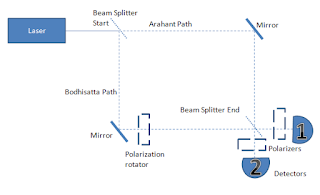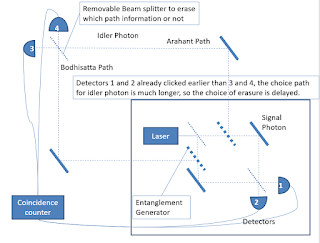There is this thing called the delayed choice quantum eraser experiment which messes up our intuition of how cause and effect should work in time as well.
Delayed choice quantum eraser is a delayed version of the quantum eraser. The quantum eraser[Experimental Realization of Wheeler’s Delayed-Choice Gedaken Experiment, Vincent Jacques, et al., Science 315, 966 (2007)] is a simple experiment. Prepare a laser, pass it through a beam splitter. In the picture of the photon, individual quanta of light, the beam splitter randomly allows the laser to either pass straight through, or to be reflected at 90 degrees downward. Put a mirror at both paths to reconnect the paths to one point, at that point, either put a beam splitter back in to recombine the laser paths or do not. Have two detectors after that point to detect which paths did the photon go. Instead of naming the paths A and B, I use Arahant Path and Bodhisattva Path.

If there is a beam splitter, we lose the information of which paths did the photons go. Light from both paths will come together to go to only one detector. If we take out the beam splitter, we get the information of which path did the photon went, if detector 1 clicks, we know it went by the Bodhisattva path, if detector 2 clicks, we know it went by the Arahant path.
So far nothing seems to be puzzling. Yet, let us look deeper, is light behaving as particle of a single photon or as waves which travel both paths simultaneously? If light is behaving like a single photon, then the addition of the beam splitter at the end should further make it randomly either go through or reflected, thus both detectors should have the chance to click. Yet what is observed is that when the second beam splitter is inserted, only detector 1 clicks. Light is behaving like waves so that both paths matters and interference happens at the second beam splitter to make the path converge again and lose the information of which paths did the light took. Take out the beam splitter at the end, then we can see which path light took, detector 1 or 2 will randomly click, thus it behaves like a photon to us.
So how light behaves depends on our action of whether to put in the beam splitter or not. Actually the more important thing is it depends on whether or not we know which path did the light took or was it erased. More complicated experiment[Multiparticle Interferometry and the superposition principle, Daniel M. Greenberger, Michael A. Horne, and Anton Zeilinger, Physics Today, pg 23-29 (August 1993)] shown below adds a polarization rotator (90o) at one of the paths and two polarisers after the end beam splitter shows that even through the polarisation rotator can allow us to tell which path did the photon took, the two polarisers (45o) after the beam splitters can erase that information, making light behave like waves and only trigger one of the detectors. If we try by any means to peek at or find out which path light took to the end, light would end up behaving like particles and trigger both detectors.

Note that the second experimental set up did not actually erase the information but rather just scrambles it. The information can be there, but as long as no one can know it, light can behave like waves. It is potential information which can be known that matters. So if we have an omniscient person like the Buddha, even he could not know which path the photon took if the information is erased and inference happens so that only one detector clicks. If he tries to find out and found out which path the light took even by some supernatural psychic powers or special powers of a Buddha, then he would have changed the nature of light to particles and make two detector clicks randomly.
Here is a bit more terminology to make you more familiar with the experiment before we go on further. Light behaves coherently with wave phenomenon of interference so that only one detector is triggered when information of which path it took is not available or erased. Light behaves like a particle, or photon, or decohered, or its wave function collapses to choose a path, randomly triggering either of the detectors, interference does not appear when information about which path it took becomes available, or not erased, even in principle.
So now onto the delayed choice quantum eraser. It is the experimental set up such that the light has already passed through the beam splitter at the start then we decide if we want to know its path or erase that information. In the first experiment above, just decide to insert or not insert the end beam splitter after the laser light has passed through the start beam splitter and are on the way to the end beam splitter. The paths can be made super long, but of the same length to make them indistinguishable, and the decision to insert the end beam splitter or not can be linked to a quantum random number generator so that it is really last split second decision and at random. Our normal intuition tells us that light has to decide if it is going to be a particle or wave at the starting beam splitter. However, it turns out that the decision can be made even after that, while it is on its way along both paths as a wave or along one of them as a particle!
Other more complicated set ups[Delayed “Choice” Quantum Eraser, Yoon-Ho Kim, Rong Yu, Sergei P. Kulik and Yanhua Shih, Marlan O. Scully, Physical Review Letters, Volume 84, Number 1 (3rd January 2000)] involves splitting the light into entangled photons and letting one-half of the split photons to be detected first, then apply the decision to either erase the information or not to onto the second half of the photons, which by virtue of its entanglement would affect whether interference pattern appears at the detected first half of the photons.
The box on the bottom right is the original experiment you had seen above. There’s an addition of entanglement generator, to get the separation of signal photon and idler photon. The signal photons are what we call the ones who end up clicking the detectors at 1 and 2. The idler photons are sent out to a longer path so that they click detector 3 and 4 at a much later time compared to 1 and 2. In principle, this time delay can be longer then a human lifespan, so no single human observer is special and required for the experiment.
The clicks at the detectors are gathered with a computer which can count the coincidence and map which signal photon is matched with which idler photon. The choice of erasure is made before the idler photon reaches detector 3 and 4. If the beam splitter is removed, we have which-way information, and thus no interference pattern at 1 and 2. If it is inserted, we have erased the which-way information and thus interference pattern can emerge at 1 and 2.
Note that this cannot be used to send messages back in time, or receive messages from the future because we need information from the second half of the photons to count the coincidence pattern of the signal photon to reveal whether or not it has the interference pattern depending on our delayed-choice on the idler photon. So when the signal photon hits the detectors, all the experimenters could see are random messes, regardless of what decision we make on the idler photon later on. This is true even if we always choose to put in the beam splitter and erase the which-way information.
If this messes with your intuition, recall what does entangled photons do. They only show correlation when you compare measurement results from both sides. If you only have access to one side, you can only see random results. So for the case of if we always erase the information, we still do not immediately see interference pattern, but the detectors 1 and 2 keeps on clicking. Each of them is actually an interference pattern, it’s just overlapping interference pattern, we need to distinguish which detectors did the idler photon clicks in 3 and 4 to separate the signal photon out. If we had done the coincidence count right and group all the signal photons corresponding to idler photon clicking detector 3, that signal photon will only trigger one of the detectors 1 or 2, showing you the interference!
In analogy to the perhaps more familiar spin entanglement you’ve some intuition about, this is like measuring entangled spin electrons. Each side measures in the same direction, and only sees a random up or down spin. It’s only when you bring them together and group which electron pairs correspond to which, do you see the correlation between each individual spins.
If we choose not to put in the erasure, then comparing the idler and signal photons, there will be no pattern of interference which appears from the coincidence counting procedure highlighted earlier. So no magic here, only boring data analysis.



No comments:
Post a Comment